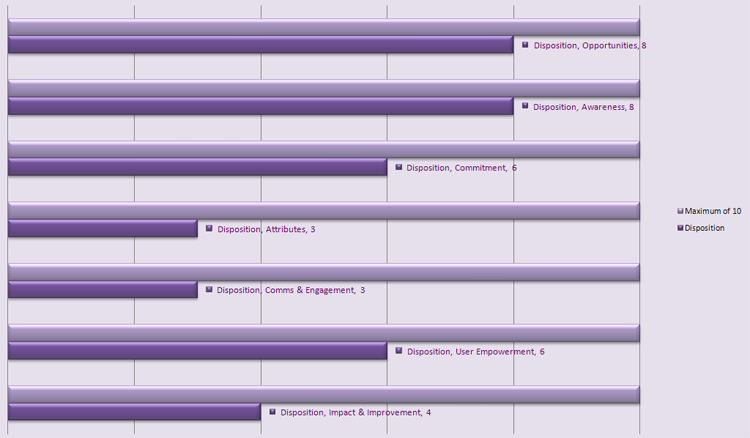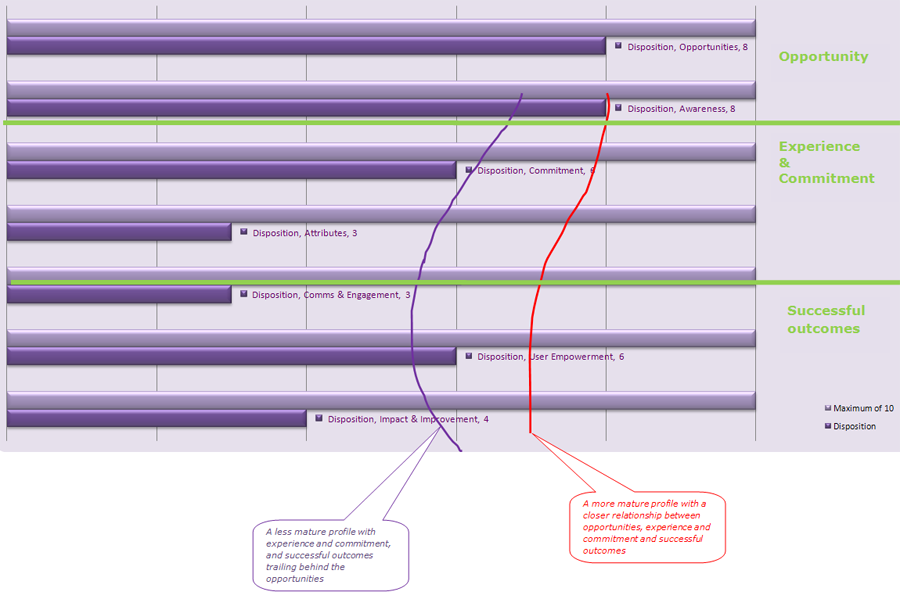6.4 Improving ICT Strategy Savvy
By analysing how ICT Strategy Savvy you are, you are assessing your personal contribution and providing a profile for self analysis and improvement. This activity is often enhanced by the use of facilitated workshops for groups, or mentors or coaches for individuals undertaking this activity.
In order for Strategic ICT to be effective in enabling institutional agility and sustainability it needs the collaborative efforts of its management and their mobilisation of the staff to achieve change. The following analyses and questions are a framework for improving your level of ICT strategy savvy and your institutional impact on strategic ICT.
Having completed the self-analysis, using the downloaded spreadsheet, a bar diagram illustrates your individual disposition profile.
The following is an example of an individual ICT strategy savvy self-analysis:
| Strategy Savvy Self-Analysis Results | Disposition | Maximum |
|---|---|---|
| Opportunities | 8 | 10 |
| Awareness | 8 | 10 |
| Commitment | 6 | 10 |
| Attributes | 3 | 10 |
| Communications & Engagement | 3 | 10 |
| User Empowerment | 6 | 10 |
| Impact & Improvement | 4 | 10 |
| Maturity Profile of 54% | 38 | 70 |
Your Strategy Savvy Self-Analysis

The disposition profile provides a visual perspective using a scale of 1 to 10 to indicate maturity in each area, as well as the net sum providing overall disposition. The profile is a self-analysis and is clearly dependent on the accuracy of the information provided. However, it provides the starting point by defining, where you are now, and the profile for your consideration and development.
The profile is presented by category which provides you with the opportunity to examine, question and formulate your specific assessment and improvement actions.
The example profile of ICT Strategy Savvy disposition can be interpreted as follows:
| Disp. | Max. | Profile Description | |
|---|---|---|---|
| Opportunity | 8 | 10 | Within the scope of their role the individual has strong opportunities to contribute and influence strategic ICT |
| Awareness | 8 | 10 | They maintain a good awareness of the factors that are involved and will influence strategic ICT |
| Commitment | 6 | 10 | The individual illustrated a moderate commitment to participating in the relevant activities |
| Attributes | 3 | 10 | But shows a relatively low self-assessment of their effectiveness across the qualities that will be called upon in their role and relevant activities |
| Communications & Engagement | 3 | 10 | The low assessment of communications illustrates a low level of relevant communications that will impact on the wider relationships within individual units, institutionally and also with ICT |
| User Empowerment | 6 | 10 | User empowerment is moderate and indicates the individual's opinion of the success and contribution of ICT as well as their pro-activeness in striving for higher user empowerment |
| Impact | 4 | 10 | The assessment for impact illustrates that this individual is moderately active and visible in assessing and taking actions that will lead to improvements in the maturity of strategic ICT |
| In Summary | 38 | 70 | Overall 54% |
In considering the ICT strategy savvy profile it is important to also consider the dependency between the assessment areas. Although we can strive for straight 10's in reality success will come from increasing opportunity and awareness and utilising the commitment and effectiveness of management to achieve success as illustrated below:
Your Strategy Savvy Self-Analysis

Now use your own profile, the following questions and the toolkit knowledge base to examine your personal self-analysis and consider:
- What can I learn about my current situation from this self-analysis
- What can I take forward and apply to my own activities
- What can I share and apply to my activities with others
- What can I share and propose as changes for a way forward with others